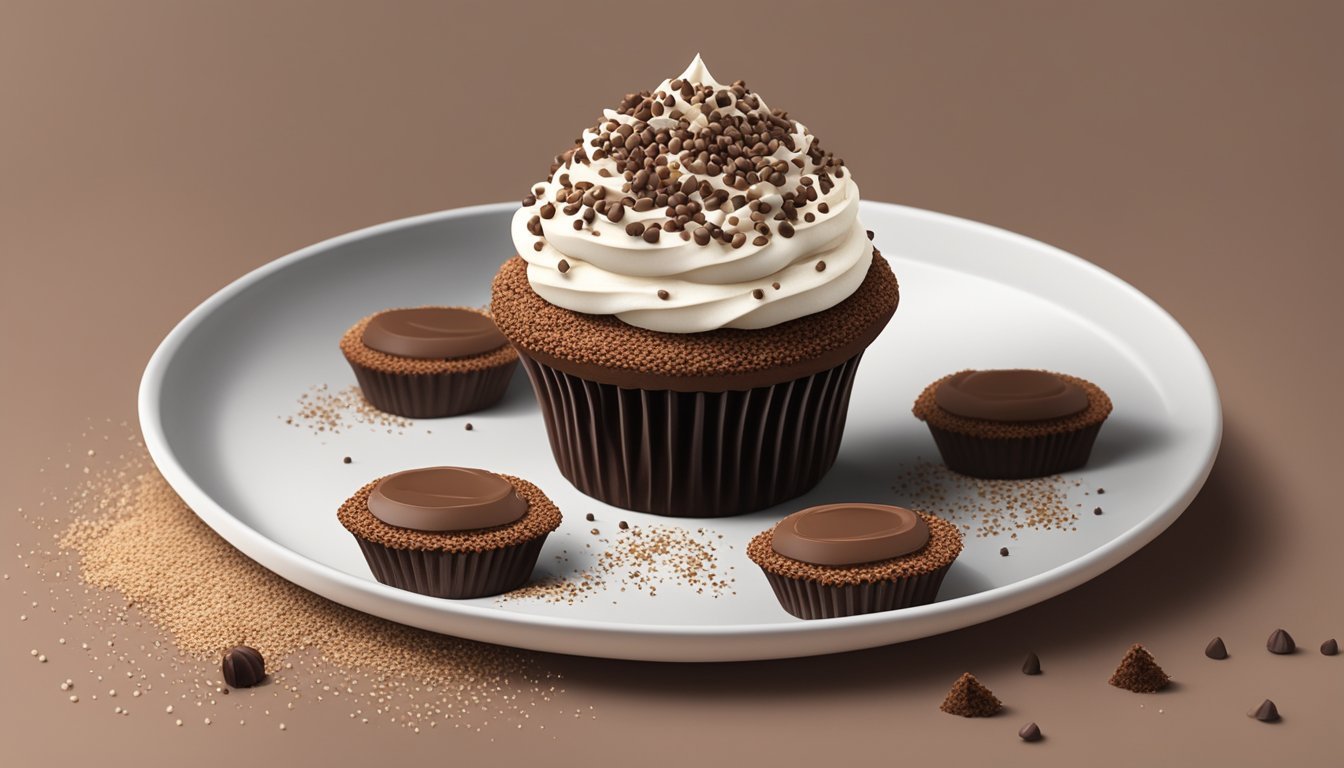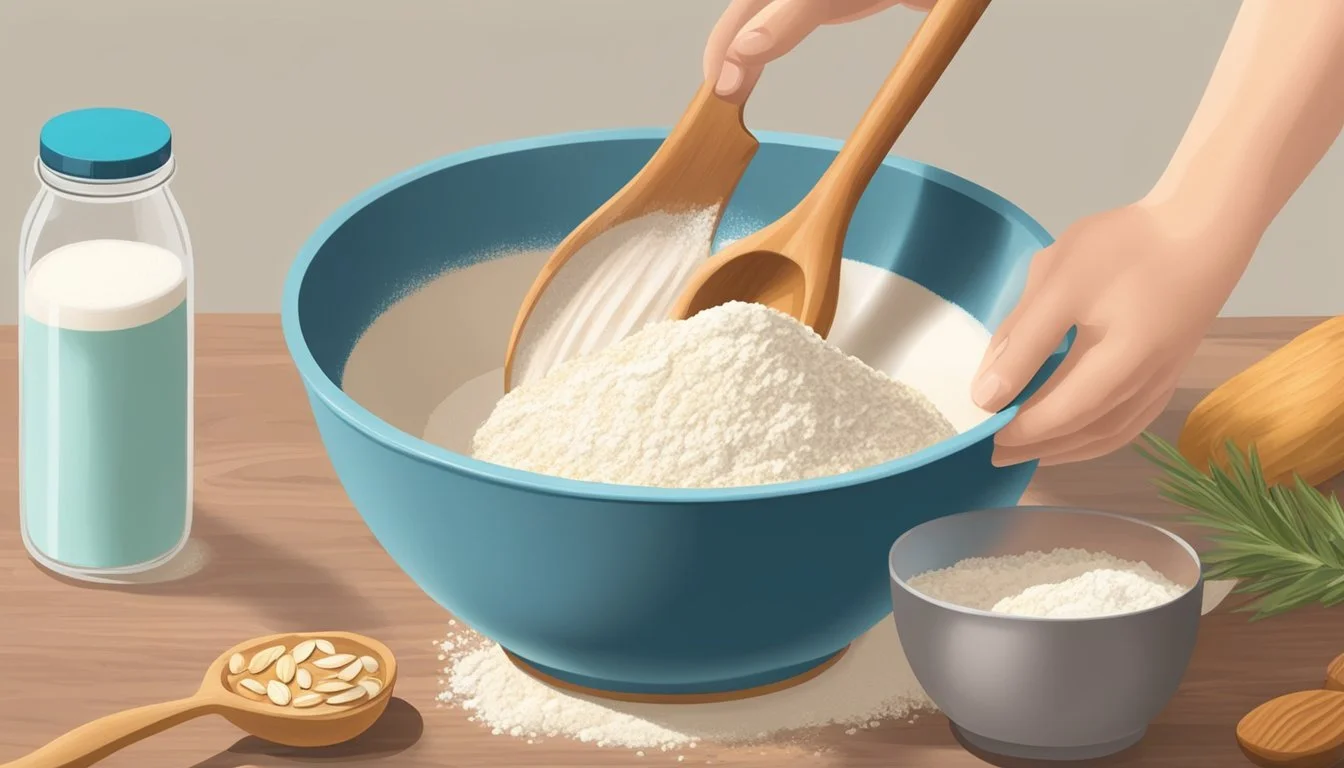Gluten-Free Chocolate Quinoa Cupcakes
Gluten-free Chocolate (What wine goes well with chocolate?) Quinoa (What wine goes well with quinoa?) Cupcakes offer a delightful twist on traditional baking. These cupcakes are not only a boon for those with gluten sensitivities but also for anyone looking to add a nutritious punch to their desserts. The main ingredient, cooked quinoa (how long does cooked quinoa last?), replaces conventional flour, providing a heartier texture and a protein boost. Unlike the typical cake or cupcake which relies on white or brown sugar for sweetness, these unique cupcakes can be sweetened with alternatives like coconut sugar or organic cane sugar, aligning with more health-conscious dietary preferences.
The preparation involves a simple but distinctive process. A food processor becomes an essential tool as it transforms the cooked quinoa into the smooth basis of the cake batter, ensuring no trace of graininess. Wet ingredients like milk—whether almond, coconut, or a preferred dairy variant—coconut oil, and vanilla extract are commonly blended with the quinoa. With the addition of dry components—cocoa powder to imbue a deep chocolate flavor, leavening agents such as baking powder and baking soda for lift, and a pinch of salt to balance the sweetness—the cupcake batter takes shape. Liners tucked into a muffin tin keep the integrity of the cupcakes as they bake, rising into a tender, moist treat.
In finishing, these cupcakes can be adorned with a range of toppings—from a simple dusting of powdered sugar to a rich, creamy chocolate ganache. Some may opt for a more traditional cream cheese (how long does cream cheese last?) frosting or a whipped coconut cream that forms soft peaks, echoing the lightness of heavy whipping cream without dairy. Served on a wire rack to cool, the end result is a batch of Gluten-free Chocolate Quinoa Cupcakes that are not only a satisfying indulgence but also a responsible choice for a range of dietary needs without compromising on the rich, indulgent experience that chocolate cupcakes promise.
Understanding the Basics of Gluten-Free Baking
In the realm of gluten-free baking, specific ingredients and techniques ensure that treats like chocolate quinoa cupcakes are both delicious and structurally sound without using traditional wheat-based flours.
The Role of Gluten-Free Flour
In traditional baking, gluten—a protein found in wheat, barley, and rye—gives baked goods structure and elasticity. Gluten-free flour substitutes, such as quinoa, must be chosen carefully to mimic these properties. Cooked quinoa acts as a novel flour replacement, lending a moist texture to cupcakes when processed into a fine consistency.
Importance of a Balanced Gluten-Free Mix
Achieving the right blend of gluten-free ingredients is crucial. While cooked quinoa provides moisture and binds the wet ingredients, adding dry ingredients like unsweetened cocoa powder and teaspoon baking soda aids in leavening and maintaining structure. A teaspoon vanilla extract can enhance flavor, whereas fats like coconut oil contribute to the richness.
Baking Powder: Essential for rise; use about 2 teaspoons per cup of gluten-free flour.
Xanthan Gum: (how long does xanthan gum last?) Needed for elasticity if the gluten-free mix lacks it.
Binding Agents: Eggs, flax seeds, or applesauce can help bind the mix.
Nutritional Benefits of Gluten-Free Ingredients
Gluten-free recipes often incorporate whole foods like quinoa, which is rich in protein and fiber. Substituting refined sugars with alternatives like coconut sugar offers a lower glycemic index. Dark chocolate chips add antioxidants, and options like almond milk or coconut milk cater to dairy-free needs as well as adding nutritional diversity to gluten-free treats.
Key Ingredients for Chocolate Quinoa Cupcakes
Crafting delectable gluten-free chocolate quinoa cupcakes relies on selecting the right ingredients to achieve the perfect balance of flavor, texture, and richness. This section details the key components that contribute to creating a successful cupcake with an emphasis on using quinoa as an innovative base and avoiding traditional flours.
Quinoa as a Base
Cooked quinoa is the secret star in these cupcakes, providing a moist and tender crumb without the need for gluten-containing flours. To prepare, one typically needs about 1 cup of dry quinoa, which is then rinsed and cooked in a saucepan with typically 2 cups of water, though actual amounts may vary. The cooked quinoa is then cooled and processed in a food processor or blender until it reaches a smooth consistency to form the base of the cupcake batter.
Chocolate for Flavor and Richness
The deep chocolate flavor in these cupcakes comes from the incorporation of either unsweetened cocoa powder or cacao powder. These ingredients contribute to a rich, chocolaty taste without adding unnecessary sweetness, making the cupcakes luxurious and satisfying. For an added touch of chocolate richness, some recipes might suggest folding in dark chocolate chips before baking.
Sweeteners and Their Substitutes
Sweeteners are necessary to balance the bitterness of cocoa powder and add to the overall flavor profile of the cupcakes. Commonly used sweeteners include white sugar, brown sugar, granulated sugar, or organic cane sugar. However, to maintain a more natural profile, alternatives like coconut sugar or even pure maple syrup are often used. These natural sweeteners might also carry additional health benefits as opposed to their refined counterparts and can contribute to the nuanced flavors of the finished cupcakes.
Step-by-Step Cupcake Recipe Guide
In this section, we delve into the details of crafting delicious gluten-free chocolate quinoa cupcakes. The process comprises preparing quinoa, mixing dry and wet ingredients, and baking to achieve the perfect texture and deep chocolate flavor.
Preparing the Quinoa
Before incorporating quinoa into the batter, it must be properly prepared. Begin by rinsing 1 cup of dry quinoa thoroughly to remove any bitterness. Soak the quinoa in water, using a ratio of 1 cup quinoa to 2 cups water, and let it sit overnight, which makes it softer and easier to blend. After soaking, drain and cook the quinoa in fresh water on medium heat until all water is absorbed and the quinoa is fluffy. Allow it to cool before moving to the next step.
Combining Dry and Wet Ingredients
In a medium bowl, whisk together your dry ingredients: 2 teaspoons baking powder, 1 teaspoon baking soda, and 1/2 cup unsweetened cocoa powder to ensure even distribution. For the wet ingredients, blend the cooled cooked quinoa with 1/2 cup milk of your choice—such as almond milk or coconut milk—along with 1/2 cup melted coconut oil, 3/4 cup coconut sugar or another preferred sweetener, and 2 teaspoons vanilla extract until smooth. Combine the wet quinoa mixture with the dry ingredients, stirring until just mixed and the batter has a uniform consistency.
Baking the Perfect Cupcake
Preheat the oven to 350°F (175°C) and prepare a muffin tin by lining the cups with liners or greasing them with a light coating of oil. Pour the cupcake batter into each cup, filling them three-quarters full to allow room for rising. Place in the oven and bake for approximately 20-25 minutes or until a toothpick inserted comes out clean or with a few crumbs attached. Once baked, let the cupcakes cool in the pan for a few minutes, then transfer them to a wire rack to cool completely. This step ensures a moist crumb and prevents the cupcakes from becoming soggy.
Enjoy your gluten-free quinoa chocolate cupcakes with a dollop of your favorite frosting, or savor their rich, chocolatey taste as is.
Customizing Your Cupcakes
Crafting the perfect gluten-free chocolate quinoa cupcakes offers an array of options for personalization. Whether adhering to dietary restrictions or exploring new flavors, these modifications cater to varied tastes and needs.
Variations for Dietary Restrictions
For dairy-free modifications, substitute cow's milk with almond milk or coconut milk. Vegan butter or coconut oil can replace unsalted butter. To create a vegan version, consider egg replacers or a flax egg in lieu of traditional eggs. For those avoiding refined sugars, replace white sugar with coconut sugar, organic cane sugar, or a liquid sweetener like maple syrup or honey.
Surprising Flavor Boosters
Adding coffee to your cupcake batter can intensify the chocolate taste, offering a deep chocolate flavor. Mix a teaspoon of espresso powder into your dry ingredients for this effect. Incorporate vanilla extract for a classic flavor enhancement or try a dollop of coconut cream for a subtle tropical twist. Mixing in dark chocolate chips gives an extra burst of chocolate with each bite.
Gluten-Free Chocolate Cupcake Varieties
Experiment with different cocoa-based ingredients—switch between cacao powder and unsweetened cocoa powder to see which you prefer. To alter texture, blend your cooked quinoa in a food processor before adding it to the mix. For a flourless chocolate cupcakes experience, focus on finely ground quinoa and increase your wet ingredients slightly for moisture.
From Cupcakes to Cakes
Transform your cupcake recipe into a chocolate quinoa cake by adjusting the baking time and pouring the batter into a parchment-lined cake pan. A single layer cake requires the same amount of batter as approximately 12 cupcakes. Once baked and cooled on a wire rack, the cake can be frosted with your choice of icing, such as cream cheese frosting or a rich chocolate ganache.
Frosting and Decoration Techniques
Creating a perfect frosting and applying it with finesse can transform gluten-free chocolate quinoa cupcakes into extraordinary treats. The following techniques ensure a smooth, creamy frosting and offer decorating tips suitable for any event.
Achieving a Smooth, Creamy Frosting
Ingredients: To achieve a smooth, creamy frosting for gluten-free chocolate quinoa cupcakes, begin with room-temperature unsalted butter or vegan butter. Use powdered sugar to avoid the grainy texture white or brown sugar might introduce.
Process: A food processor or stand mixer can whip the frosting to a desirable consistency. For a deeper chocolate flavor, incorporate unsweetened cocoa powder or melted dark chocolate chips into the mixture.
Texture: Add a few tablespoons of cup milk—almond, coconut, or your preferred milk— to adjust the thickness. To maintain stability, mix until just combined to avoid introducing excess air bubbles, which can create a less smooth texture.
Decorating Tips for Every Occasion
Piping Techniques: Utilize a variety of piping tips to design patterns such as rosettes, stars, or swirls. For birthday celebrations, opt for brighter, more playful designs, while an elegant event might call for subtler, sophisticated strokes.
Toppings: Sprinkle with gluten-free decorations like crushed gluten-free cookies, quinoa crisps, or fruit pieces. For an added touch, finish with a drizzle of chocolate ganache or coconut cream.
Themed Decorating: Customize the cupcakes with themed toppers or edible images to match the occasion, ensuring the decorations are also gluten-free to complement the flourless chocolate cupcakes base.
Using these frosting and decoration techniques, gluten-free quinoa chocolate cupcakes can be as visually stunning as they are delicious, making them ideal for any gathering or special moment.
Tips for Storing and Serving Cupcakes
Ensuring that your gluten-free quinoa chocolate cupcakes retain their delightful moisture and fluffiness requires proper storage and serving techniques. Following these strategies will help maintain the cupcakes' quality from the moment they cool on the wire rack to when they are served.
How to Keep Cupcakes Moist and Fluffy
To preserve the moist and fluffy texture of your cupcakes, follow these steps:
Once cooled, store cupcakes in an airtight container to prevent air from drying them out.
If cupcakes are unfrosted, you can keep them at room temperature for one to two days. Frosted cupcakes, depending on the type of frosting, may need refrigeration.
Avoid storing in the refrigerator unless necessary as it can dry out the cupcakes. If refrigeration is required, bring them to room temperature before serving to ensure best flavor and texture.
Best Practices for Cupcake Freshness
For optimal freshness:
Bake cupcakes as close to serving time as possible.
If storing in a container, line the bottom with parchment paper to absorb any excess moisture.
Should cupcakes need to be stored beyond a day or two, freezing them is the best option. Wrap each cupcake individually in plastic wrap and then place them in a sealed container before freezing.
Thaw cupcakes in the refrigerator, then at room temperature while still wrapped to minimize condensation which can make the tops gooey.
Serve cupcakes at room temperature as this brings out the flavors of the unsweetened cocoa powder and vanilla extract, and makes for a softer cake crumb.
Understanding Cupcake Nutrition
When it comes to the nutrition of gluten-free chocolate quinoa cupcakes, it's crucial to consider both their overall energy content and the specific nutrients they offer.
Calorie and Macronutrient Breakdown
Gluten-free chocolate quinoa cupcakes derive their calories from a balance of carbohydrates, proteins, and fats. Cooked quinoa acts as a nutritious flour replacement, contributing complex carbohydrates and a moderate amount of protein. The inclusion of unsweetened cocoa powder adds minimal calories but is crucial for the deep chocolate flavor. Fats in the recipe may come from ingredients like coconut oil or other plant-based oils, which are used in lieu of traditional dairy products. Sugars—for sweetness—can range from white sugar to alternative sweeteners like coconut sugar, influencing both the caloric content and glycemic index of the cupcakes.
For a standard gluten-free chocolate quinoa cupcake, the approximate macronutrient distribution is as follows:
Calories
Amount per serving: 200-250 kcal
Carbohydrates
Amount per serving: 30-40 g
Proteins
Amount per serving: 3-5 g
Fats
Amount per serving: 10-15 g
Dietary Fiber
Amount per serving: 2-3 g
Sugars
Amount per serving: 15-25 g
Vitamins and Minerals in Your Cupcakes
The nutritional value of these cupcakes extends beyond macronutrients. Quinoa is rich in vitamins like B-vitamins and minerals such as magnesium, iron, and potassium. These nutrients are essential for energy metabolism and overall health. Cocoa powder, especially when less processed like cacao powder, contains antioxidants and minerals such as calcium and magnesium. When milk is added to the recipe, whether it's cow's milk or a plant-based alternative like almond milk or coconut milk, it further contributes to the calcium and vitamin D content of the cupcakes.
Finally, the selection of additional ingredients like dark chocolate chips for topping or garnished layers, and the type of sweetener used, will impact the cupcakes' final nutritional profile. Opting for darker chocolate with a higher cocoa content and less sugar can enhance the nutritional value, while a heavy ganache topping might add extra calories and fats.
Advanced Techniques and Troubleshooting
Perfecting the art of gluten-free baking requires a grasp of specific techniques and understanding potential pitfalls. This section breaks down the advanced use of kitchen appliances and troubleshooting common baking issues.
Using Food Processors and Blenders
Utilizing a food processor or blender is essential for achieving a smooth batter when creating flourless chocolate cupcakes with quinoa. Start by rinsing 1 cup of dry quinoa thoroughly to remove any bitterness. For an evenly cooked quinoa, use 2 cups of water per cup of quinoa, bringing it to a boil, then simmering on medium-low heat for 15-20 minutes until tender. Once the quinoa is cool, blend it until a smooth paste forms, ensuring there are no lumps in your cupcake batter. This quinoa mixture will lend a moist texture to the cupcakes without traditional flour.
When blending wet ingredients like coconut oil, vanilla extract, and preferable milk (such as almond or coconut milk), ensure they are at room temperature to facilitate a consistent blend. For adding a rich taste, incorporate dark chocolate chips or unsweetened cocoa powder into the mix, blending until the chocolate is fully integrated and the mixture has a deep chocolate flavor.
Common Baking Issues and Solutions
Baking gluten-free quinoa chocolate cupcakes can come with its unique set of challenges. Here's a concise guide to tackling them:
Cupcakes Not Rising: If your cupcakes aren't rising, check the freshness of your baking powder and baking soda. They lose potency over time. Use 1 1/2 teaspoons of baking powder and 1/2 teaspoon of baking soda for the right leavening action.
Dense or Gummy Texture: A common mistake is over-mixing the batter. Mix until just combined to avoid dense cupcakes. Also, ensure to fully whisk your dry ingredients including sugar, whether you're using coconut sugar, white sugar, or organic cane sugar, to distribute the teaspoon of baking soda and teaspoons of baking powder evenly.
Dry Cupcakes: This could be due to over-baking or incorrect oven temperature. Bake your cupcakes just until a toothpick inserted comes out clean. Use an oven thermometer to verify accuracy.
Sticking to the Liners: To prevent sticking, line the muffin tin bottoms with parchment paper and use non-stick spray or liners. Allow the cupcakes to cool on a wire rack after a few minutes out of the oven.
Persistently check your cupcakes for doneness starting a few minutes before the expected baking time to prevent over-baking. Remember, with gluten-free baking, each cake layer or cupcake may bake differently due to varied moisture content, so adjust accordingly.





